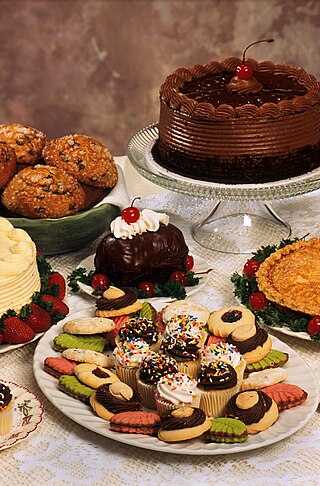
Dessert is a course that concludes a meal. The course consists of sweet foods, such as cake, biscuit, ice cream and possibly a beverage such as dessert wine and liqueur. Some cultures sweeten foods that are more commonly savory to create desserts. In some parts of the world there is no tradition of a dessert course to conclude a meal.

A chocolate chip cookie is a drop cookie that features chocolate chips or chocolate morsels as its distinguishing ingredient. Chocolate chip cookies are claimed to have originated in the United States in 1938, when Ruth Graves Wakefield chopped up a Nestlé semi-sweet chocolate bar and added the chopped chocolate to a cookie recipe; however, historical recipes for grated or chopped chocolate cookies exist prior to 1938 by various other authors.
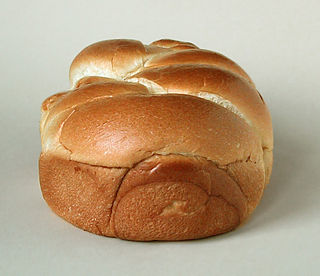
The Maillard reaction is a chemical reaction between amino acids and reducing sugars to create melanoidins, the compounds that give browned food its distinctive flavor. Seared steaks, fried dumplings, cookies and other kinds of biscuits, breads, toasted marshmallows, falafel and many other foods undergo this reaction. It is named after French chemist Louis Camille Maillard, who first described it in 1912 while attempting to reproduce biological protein synthesis. The reaction is a form of non-enzymatic browning which typically proceeds rapidly from around 140 to 165 °C. Many recipes call for an oven temperature high enough to ensure that a Maillard reaction occurs. At higher temperatures, caramelization and subsequently pyrolysis become more pronounced.
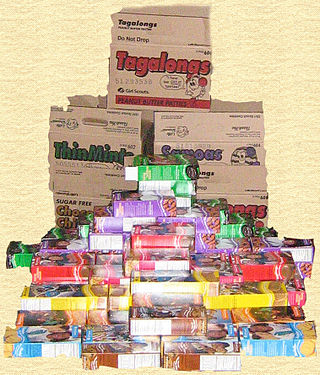
Girl Scout Cookies are cookies sold by Girl Scouts in the United States to raise funds to support Girl Scout councils and individual troops. The cookies are widely popular and are commonly sold by going door-to-door, online, through school or town fundraisers, or at "cookie booths" set up at storefronts. The program is intended to both raise money and improve the financial literacy of girls. During an average selling season, more than one million girls sell over 200 million packages of cookies and raise over $800 million. The first known sale of cookies by Girl Scouts was in 1917. Cookie sales are organized by 112 regional Girl Scout councils who select one of two national bakeries to buy cookies from.

Cream soda is a sweet soft drink. Generally flavored with vanilla and based on the taste of an ice cream float, a wide range of variations can be found worldwide.

Cheesecake is a dessert made with a soft fresh cheese, eggs, and sugar. It may have a crust or base made from crushed cookies, graham crackers, pastry, or sometimes sponge cake. Cheesecake may be baked or unbaked, and is usually served chilled.

A macaroon is a small cake or cookie, originally made from ground almonds, egg whites, and sugar, but now often with coconut or other nuts. They may also include jam, chocolate, or other flavorings.

Shortcake generally refers to a dessert with a crumbly scone-like texture. There are multiple variations of shortcake, most of which are served with fruit and cream. One of the most popular is strawberry shortcake, which is typically served with whipped cream. Other variations common in the UK are blackberry and clotted cream shortcake and lemon berry shortcake, which is served with lemon curd in place of cream.
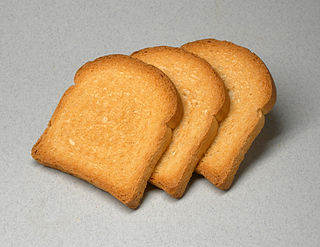
A rusk is a hard, dry biscuit or a twice-baked bread. It is sometimes used as a teether for babies. In some cultures, rusk is made of cake, rather than bread: this is sometimes referred to as cake rusk. In the UK, the name also refers to a wheat-based food additive.

Biscotti are Italian almond biscuits originating in the city of Prato, Tuscany. They are twice-baked, oblong-shaped, dry, and crunchy. In Italy, they are known as cantucci, biscotti di Prato or biscotti etruschi and may be dipped in a drink, traditionally Vin Santo. Smaller biscotti may be known as biscottini or cantuccini. In Italian, the word biscotti encompasses all types of biscuits or cookies.

A macaron or French macaroon is a sweet meringue-based confection made with egg white, icing sugar, granulated sugar, almond meal, and often food colouring.

Lane cake, also known as prize cake or Alabama Lane cake, is a bourbon-laced baked cake traditional in the American South. It was invented or popularized by Emma Rylander Lane (1856–1904), a native and long-time resident of Americus, Georgia, who developed the recipe while living in Clayton, Alabama, in the 1890s. She published the original recipe in Some Good Things to Eat (1898). Her original recipe included 8 egg whites, 1 cup butter, 1 cup sweet milk, 2 cups sifted sugar, 3 ¼ cups sifted flour, 2 teaspoons baking powder, 1 tablespoon vanilla and called for the layers to be baked in pie tins lined with ungreased brown paper rather than in cake pans. The filling called for 8 egg yolks, 1 cup of sugar, 1/2 cup butter, 1 cup seeded raisins, 1 wine-glass of whiskey or brandy, and 1 teaspoon vanilla.

Jumbles are simple butter cookies made with a basic recipe of flour, sugar, eggs, and butter. They can be flavored with vanilla, anise, caraway seed, or other flavoring like almond. They were formerly often made in the form of rings or rolls.
Biscuits Fossier is a Reims, France based manufacturer of biscuits, gingerbread, sweets and marzipan-based confectionery.
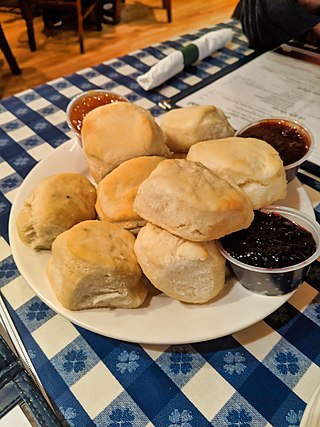
In the United States, a biscuit is a variety of baked bread with a firm, dry exterior and a soft, crumbly interior. In Canada it sometimes also refers to this or a traditional European biscuit. It is made with baking powder as a leavening agent rather than yeast, and at times is called a baking powder biscuit to differentiate it from other types. Like other forms of bread, a biscuit is often served with butter or other condiments, flavored with other ingredients, or combined with other types of food to make sandwiches or other dishes.

Sponge cake is a light cake made with eggs, flour and sugar, sometimes leavened with baking powder. Some sponge cakes do not contain egg yolks, like angel food cake, but most of them do. Sponge cakes, leavened with beaten eggs, originated during the Renaissance, possibly in Spain. The sponge cake is thought to be one of the first non-yeasted cakes, and the earliest attested sponge cake recipe in English is found in a book by the British poet Gervase Markham, The English Huswife, Containing the Inward and Outward Virtues Which Ought to Be in a Complete Woman (1615). Still, the cake was much more like a cracker: thin and crispy. Sponge cakes became the cake recognised today when bakers started using beaten eggs as a rising agent in the mid-18th century. The Victorian creation of baking powder by British food manufacturer Alfred Bird in 1843 allowed the addition of butter to the traditional sponge recipe, resulting in the creation of the Victoria sponge. Cakes are available in many flavours and have many recipes as well. Sponge cakes have become snack cakes via the Twinkie.

Qurabiya also ghraybe, ghorayeba, ghoriba, ghribia, ghraïba, gurabija, ghriyyaba,, kurabiye, or kourabiedes and numerous other spellings and pronunciations, is a shortbread-type biscuit, usually made with ground almonds. Versions are found in most Arab, Balkan and Ottoman cuisines, with various different forms and recipes. They are similar to polvorones from Andalusia.

Barquillo is a crispy rolled wafer pastry originating in Spain. It is made from the basic cookie ingredients of flour, sugar, egg whites and butter rolled out thinly and then shaped into a hollow cylinder or a cone. It was traditionally sold by roadside vendors known as barquilleros who carried a characteristic red roulette tin. It was introduced to Latin America and the Philippines during colonial times. In Spain and former Spanish colonies, barquillos are commonly regarded as a type of Christmas cookie. It is also popular during various fiestas. It spread to neighboring countries and today is extremely popular in East and Southeast Asian countries.

Clementine cake is a flourless cake flavored primarily with whole unpeeled clementines and almonds. It may originate from an orange cake in Sephardic cuisine. In popular culture, the cake played a minor part in the plot of the 2013 film The Secret Life of Walter Mitty.


















